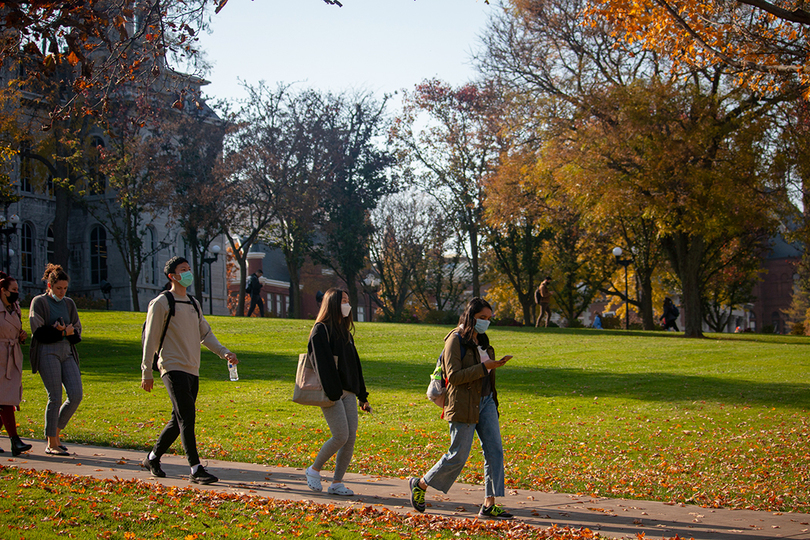As COVID-19 cases increase on campus, here are ways to stay safe

According to the Centers for Disease Control and Prevention, the county is at a “medium” COVID-19 Community Level as of Sept. 18. Meghan Hendricks | Photo Editor
Get the latest Syracuse news delivered right to your inbox.
Subscribe to our newsletter here.
Syracuse University currently has 104 self-reported active cases of COVID-19 on its campus as of Sept. 17, a university spokesperson said.
As cases continue to rise, here’s how to stay safe despite looser campus safety guidelines.
The current state of COVID-19
Onondaga County and New York state continuously publish daily data regarding the virus. On Sept. 17, the county reported 26 cases per 100,000 people and a positivity rate of 10.2%. The county’s average over the last seven days is only slightly different, with a positivity rate of 10.1% and 25.8 cases per 100,000 people.
According to the Centers for Disease Control and Prevention, the county is at a “medium” COVID-19 Community Level as of Sept. 18. Under the level, the CDC recommends people who are at a high risk of getting “very sick” – including those who are 50 years or older, immunocompromised people and those with underlying health conditions – wear a high quality mask or respirator when indoors in public.
Omicron BA.5 is the dominant COVID-19 variant in New York state. The variant does not seem to be more dangerous than previous variants, according to Yale New Haven Health.
Staying Safe
Students with COVID-19 symptoms can get tested at the Barnes Center at the Arch. The university is providing at-home testing kits, available at the Schine Student Center, Goldstein Student Center, the Barnes Center, Dineen Hall, the Life Sciences Complex and the Mount, for anyone who is asymptomatic.
The tests cost a dollar and students can purchase them using credit or debit cards as well as cash.
SU is still working to obtain the new coronavirus vaccine, which targets specific variants, said Sarah Scalese, SU’s senior associate vice president for communications.

What do you do if you’re exposed to COVID-19?
SU is following the CDC’s guidelines for both COVID-19 exposure and isolation.
According to the CDC, after exposure, people should take proper precautions for 10 days, starting the first full day after exposure. The day a person is exposed to COVID-19 is their “Day 0.” During those 10 days, the CDC recommends wearing a “high quality” mask or respirator around others and reducing travel as much as possible. The CDC also recommends taking extra precautions when around people at a higher risk of severe illness.
On the sixth day after exposure, the CDC recommends people test themselves for COVID-19. If the person tests negative, they should continue to take precautions until the 10th day. If the person tests positive, the CDC recommends that they begin to isolate.
What do you do if you test positive for COVID-19?
The university encourages students who test positive using an at-home COVID-19 testing kit or through an outside source to report it to the Barnes Center.
If a student who lives in university housing tests positive, they can utilize SU’s isolation housing at Skyhall I and on South Campus, Scalese said. As of Sept. 17, the university has 20 students in isolation.
Students living off-campus need to find their own isolation housing if necessary, Scalese said. Whether a person is isolating off-campus or in university housing, the CDC’s recommendations do not change.
If a person tests positive for COVID-19 while feeling symptoms of the virus, their “day zero” of isolation is when they first start feeling their symptoms, according to the CDC. If a person is asymptomatic, their “day zero” begins when they test positive.
The CDC recommends isolating for at least five days. During the period, people isolating should wear a high-quality mask, stay home as much as possible, use their own bathroom, take steps to improve their residence’s ventilation and monitor their own symptoms.
Patients can end their isolation if they test negative on the fifth day and haven’t had a fever for 24 hours, according to the CDC. Students living on campus should still use grab-and-go food options for the six to ten days after quarantine, Scalese said.
If symptoms are not improving on the fifth day of isolation, the CDC recommends leaving isolation only when symptoms start to improve and a person has been fever-free for 24 hours without medication.




